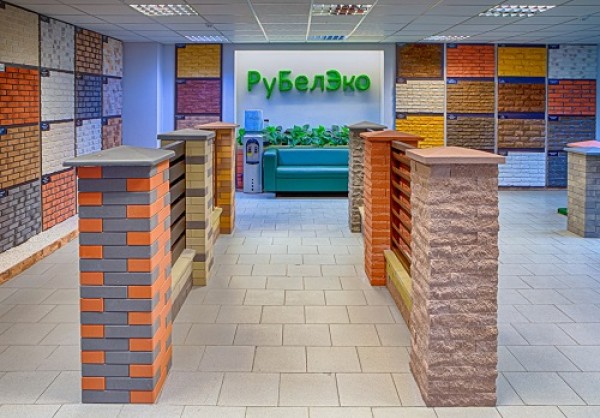
RubelEco Company: hyper-pressed reality for brick products
12.09.2024. Hyper-pressing technology, relatively young in terms of industrial prevalence, appeared in the Soviet Union. Experimental production of building materials based on hyper-pressing technology dates back to the 60s of the last century. There are rumors that this technology was banned for industrial implementation. The final product - hyper-pressed brick - turned out to be very refined, noble and diverse, both in texture and color. And in Soviet times, as you know, a monotonous and typical approach to the mass construction of affordable housing was at the forefront.
Nevertheless, since the early 90s, hyper-pressed products began to methodically and confidently conquer their "place in the sun", and are currently very popular and popular finishing materials in the Russian Federation and Ukraine.
What is the essence of the proposed technology? Let's consider what the production of brick products by hyperpressing actually is.
The main essence of this technology is that by the method of so-called "cold welding" with the help of powerful presses three components are firmly connected into a single whole: the material of carbonate rock (in our case it is dolomite), cement binder and mineral pigment based on iron oxides.
Key points of the technology that provide excellent properties of our products.
Dolomite as the main component of the raw mix
As is known, an important distinctive feature of carbonate rocks, to which our dolomite belongs, is that in a crushed state they are not inert, but enter into active physical and chemical interaction with clinker minerals of the binder (Portland cement), participating in the formation of a stronger and more homogeneous structure of cement stone - a hyperpressed product.
Preliminary mechanical activation of the raw mix
During intensive mixing and grinding of the components, the passive (inactive) surface of both cement and dolomite transitions to a chemically active state, which is expressed in their increased ability to react during subsequent technological operations. Thus, from the very beginning of the production and technological chain, a prerequisite is provided, with the help of which at the output we obtain a strong, reliable in masonry, and therefore durable building material.
Modern pressing equipment
Two-sided step hyperpressing with a force of at least 300 kg / cm2: contributes to achieving a high degree of homogeneity and compaction of the product structure, as well as the removal of trapped air; ensures the emergence of cohesive adhesion of filler grains between themselves and the most dense contact with binder particles; guarantees high geometric accuracy of the dimensions of the final products.
Heat and humidity treatment of products
Ensuring optimal heat and humidity conditions for processing in a saturated steam environment is not a know-how of hyperpressing technology, however, as in the case of the production of traditional concrete products, it helps to create favorable conditions for the rapid and uniform strength gain of finished products.
The result of a consistent combination of the listed modern scientific and technical solutions and strict production control in a single technological chain is a new product that surpasses in its characteristics the facing building materials presented on the market: sand-lime and ceramic bricks, vibration-pressed concrete products.
What are the advantages of our hyper-pressed products?
High mechanical strength and frost resistance
In terms of compressive strength, hyper-pressed facing bricks belong to grades from M200 to M400 and more, depending on the emptiness of the products. Frost resistance corresponds to grades from F100 to F150, which is several times higher than the corresponding indicator for ceramic and silicate products. All this indicates exceptional operational durability of building structures made of hyper-pressed products. In other words, do not worry about the question: "What will we leave to our grandchildren?"
Ultra-precision of the shape and size of the final product
Deviations from the specified geometric parameters do not exceed ± 0.5 mm, which has a beneficial effect on the accuracy of the masonry, and therefore on the appearance of the facade of the house, fence or fireplace.
High adhesion strength in masonry
This indicator reflects the ability of brickwork in load-bearing structures of buildings to withstand destructive forces from wind loads and uneven settlement of building foundations. The key factors that ensure high bond strength in masonry are the physical and chemical relationship of the hyper-pressed brick material with cement mortar, as well as the optimal level of water absorption of the products, which is 6–9%.
Attractive appearance. Wide range of products
Thanks to the use of volumetric painting and decorative chipping technologies, modern production of hyper-pressed bricks meets the growing demands of customers for individuality and aesthetic appeal of housing.
Technical equipment allows us to produce products not only in the usual brick size, but also unique product positions for the Belarusian market, allowing you to lighten the structure of your facade: narrow hollow brick 250×60×65 mm; similar in format to the front surface of the brick, facade facing tiles 250×65×20 mm.
A wide range of colors, the ability to combine different textures and standard sizes of products will allow you to do everything exactly as you intended. Do not settle for only smooth standard finishing options, experiment, be different, combine.
If you have any questions or suggestions regarding our facing products, you can send them to us by e-mail: info@rubeleco.by
Perhaps your suggestions will become the topic of our new materials!
Our website: https://rubeleco.by/
